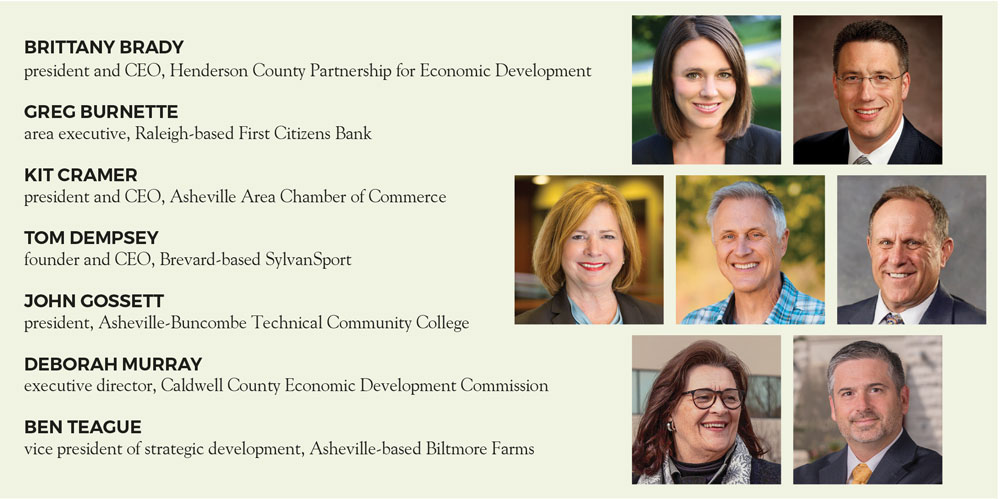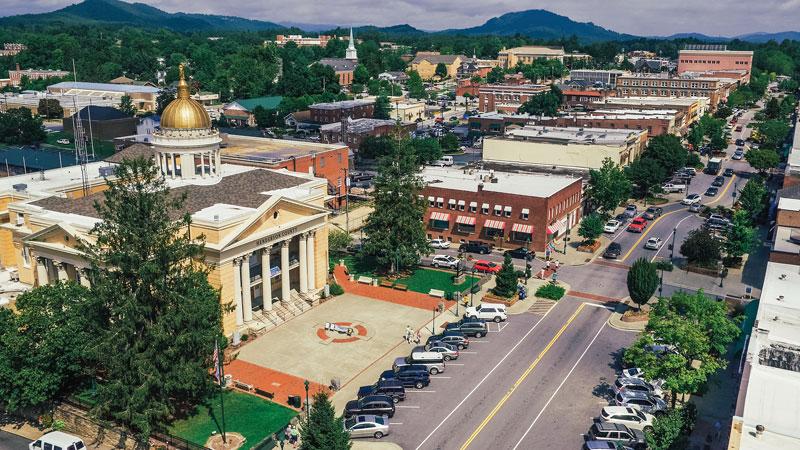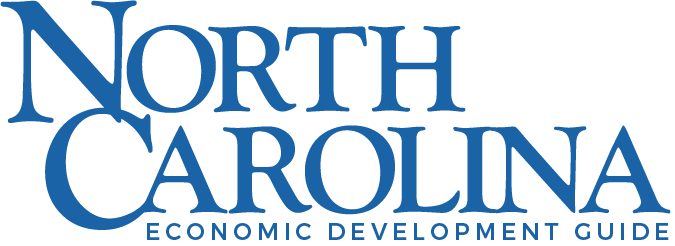Focus: Western region, rising higher
Western North Carolina’s beautiful views, recreational opportunities and unique amenities create a quality of life that’s hard to match anywhere else. The COVID-19 pandemic highlighted those benefits, attracting more people and businesses to the mountains. While new development often brings good things, it also creates challenges. Following in the footsteps of the region’s hardy Scotch-Irish settlers, community and business leaders are digging in, working hard and creating clever responses. Seven experts from the region gathered to discuss the issues, solutions and how they can be leveraged for an even better future.

What challenges did COVID present? What did it teach you?
MURRAY: The past year was tough, but it was amazingly good, too. Furniture manufacturing was hit fast and hard. Our unemployment rate jumped to 16.3% in April 2020. It hadn’t been that high since the Great Recession. We’ve recovered for the most part — unemployment was 4.5% in April 2021, according to the most recent data from N.C. Department of Commerce. But the labor shortage and supply chain issues are causing fits as they are elsewhere. Caldwell County had one of its best years for new private investment and number of completed projects. Our project pipeline remains full and busy. Partnerships and collaborations were the best things to come from the past year. The highest levels of leadership in health care, education, government, business and industry — everybody had a seat at the
table. We meet regularly and will continue to as we move forward.
BURNETTE: While the region fared well over the past year, there were businesses, especially in the hospitality industry, that suffered. Many of them displayed resiliency, flexibility and adaptability, whether it was a restaurant moving to carryout only while on the fly or a manufacturer shifting to personal protective equipment production. Hospitality businesses continue to deal with the pandemic’s effects as they bounce back. Manufacturers are doing well.
BRADY: When the world shut down in March 2020, we thought, we thought we would have two weeks to work on pet projects. Boy, we were wrong. The first two weeks were dedicated to figuring out what was happening. Our manufacturing community was deemed essential, so its members needed to find ways to safely continue their work. We saw the pandemic’s problems and its opportunities. We had a company locate here instead of expanding internationally. We saw health care continue to thrive with Jabil’s $38 million expansion into Henderson County. It’s expected to create 150 jobs by 2025. The county’s unemployment rose to 14.6% in April 2020, falling to 3.6% one year later. But unemployment in the advanced manufacturing sector was still 10% in late May 2021. When it comes to the jobs that our organization caters to, we believe that the workforce is about 15,000 people short. We’re trying to be resilient and creative, keeping the momentum, meeting supply and demand, and fostering a successful manufacturing community.
TEAGUE: The past year was an interesting time. Biltmore Farms has hotels, office space and retail. Its land holdings include the 1,000-acre planned development Biltmore Park West, where aviation manufacturer Pratt & Whitney is investing $650 million to build a 1-million-square-foot factory and create 800 jobs. It’s expected to start manufacturing turbine airfoils next year. When the tide of good fortune ebbs, you discover who you are and what you’re made of. The region’s brand is strong. People come here to live healthy lives. They view it as a respite, an outdoor mecca kind of place. But the pandemic also uncovered some of the region’s softer points. Hospitality can’t support everybody. It can’t be the mainstay of how we thrive. There were times over the past year, for example, when only a handful of Biltmore Farms’ hundreds of hotel rooms were booked. So, we have to continue to focus on manufacturing, corporate roles and creating career ladders, not just jobs. That’s what this Pratt & Whitney project represents. Many of its jobs pay about $70,000 annually. That’s a huge chunk of capital being injected into the market. But they also bring intellectual capital for our community. We’re excited about that. The region has a bright future.
CRAMER: It has been the best of times and worst of times. We went from being No. 1 in the state with low unemployment to being at the top of that list soon after the pandemic’s start. Our great restaurants, unique small businesses and hotels were quickly and severely impacted by shutdowns and stay at home orders. We’ve rebounded by about 24,000 jobs, but our working population remains below prepandemic levels. There’s a tendency for people statewide to see us as tourism dependent. But we’re more than tourism. We landed Pratt & Whitney, the region’s largest manufacturing project in terms of investment and new jobs. The basics of our economy are strong, and I’m bullish about the future.
DEMPSEY: We were at full stop in late March 2020. A truckload of exhibit materials was pulling away from our loading dock when we told its driver not to leave. We shifted to PPE production within a week. That kept our team working. It was fortuitous that we could shift quickly. If we waited one more week, it would have been too late. We are a manufacturer and a tourist destination. Almost a thousand families pick up their camper at our factory each year, and many immediately start their vacation in western North Carolina. Our complete shift to selling direct to consumers began at the end of 2019, and our timing couldn’t have been better. The outdoor industry exploded about midway through 2020 as people pursued one of the only activities that respected pandemic-induced directives. We’ve set business records each month since July 2020. It’s a little awkward succeeding while others struggle because of no fault of their own. But we look at the silver lining and count our blessings.
GOSSETT: A-B Tech never closed because of the pandemic. We were still teaching. Students attended lectures online and only visited campus for labs and clinicals. I’m proud of my team, who implemented COVID precautions, keeping the pandemic at bay on campus. But people were still fearful. And like most community colleges nationwide and all but a few in North Carolina, our enrollment declined. Broadband internet access contributed to that as did access to internet-capable devices. When K-12 schools switched to remote learning, many moms and dads stayed home. We discovered that if those families had only one device, the school-aged child had first dibs. Mom and dad were forced to use it late at night or early in the morning. That pressure was too much, so many stepped away from their studies or workforce development opportunities. We understand that people were forced to make choices. We hear that they want to return to campus. We’re expecting an enrollment jump this fall.

Hendersonville
The region’s high quality of life attracts many people. What challenges does a growing population pose? What are the solutions?
CRAMER: Neighboring communities will be affected by the Pratt & Whitney project, especially the number of people it will bring. We’re talking with homebuilders about it in terms of the current housing supply. We want them to focus on workforce housing. We need as much workforce housing as possible included in developments. We’ve been discussing ways to encourage it with local governments.
GOSSETT: We’ve had some prospective employees turn down a job offer because of living costs. If we stay within our pay scale, they can’t afford housing. It’s disheartening. So, we have been developing local talent — people who already are living and playing in Buncombe County.
BURNETTE: Real estate in the region has become very attractive. More people are moving here from densely populated places, attracted by the quality of life. There’s been a digital shift — individuals realizing that technology allows them to work from anywhere — underway for many years. But the pandemic is pushing that transformation. We need homebuilders to recognize this need. If I have property, how can I maximize the return on investment versus positively impact the community. The public and private sectors have to continue to talk about it and take action. There are a variety of programs to finance homes, so it’s not a capital issue. It’s an inventory issue.
MURRAY: The economic developer’s role has changed. A few years ago, it was novel to say you’re more about the holistic aspects of economic development. That’s the only way it works today. Our housing issue is tough. The Great Recession stopped housing development. We have aging single family and multifamily homes. Our first new multifamily housing project that’s not subsidized housing happened in 2021. We’re celebrating, believing it will lead to more similar projects. We have the same approach to single family development. We need low-, middle- and high-tier housing. Many local employers mention losing potential employees because of not being able to find housing. So, the EDC assembled a booklet that details housing options. Finding them has required going farther outside the immediate area. We are growing our own workers through the local school system and the community college’s career and technical education programs. The EDC has a new summer jobs program, which introduces high-school graduates to the working world. Opportunities in the region are increasing. That’s worrisome because we need to fill the growing labor gap.
BRADY: It seems every time I pick up the newspaper, another proposed development has gone before city council or the planning department. The housing challenge comes with opportunities. We’ve developed a relocation guide, which we wouldn’t have done five years ago. It will help us land talent, including giving locals who left for college and hadn’t considered returning home a reason to move back. And so just like there is short term, midterm and long-term strategies for workforce development, we believe there is short term, midterm and long-term strategies for housing.
DEMPSEY: About half of our employees are from Henderson County. Some are from Buncombe County, and some are from upstate South Carolina. We’re recruiting for many technical positions, which pay well, but we’ve had to increase pay to cover living costs. I personally have helped find housing for folks that we want to hire. We just brought in a talented engineer from Texas. Fortunately, he and his wife live in a tiny house, so they relocated it to a tiny house village in Henderson County. If everyone could have that circumstance, it would lift a huge burden. We also are developing internal talent as it has becomes more difficult to relocate people quickly.
TEAGUE: It doesn’t matter how much you pay a person: It’s a problem if there’s nowhere for their child to go for a safe and quality education, especially as we leave the pandemic behind and more people return to work. And it’s not enough to just create jobs. Getting on the bottom rung of the career ladder is good. And having high-end jobs is good. But it’s not good if you have to leave the region to climb the rungs in between. We must create opportunities, so people can work their way up that ladder.
What are some of the region’s needs? How can they be addressed?
GOSSETT: I came here in the middle of the pandemic. People made an effort to reach out to me, including A-B Tech in what they are doing and allowing us to share what we’re doing. That collaborative attitude is exciting. We can’t live in silos. We have to work together; the lift is much lighter when we do. At a recent strategic planning meeting, we discussed more than which programs to add or subtract. We want to change higher education’s culture. In the past, students were on their own, and only the strong survived. We can’t do that anymore. We have to reach out to students and remove barriers, including offering childcare and helping them land jobs. Those weren’t discussed when I started in higher education 30 years ago. They’re discussed daily today.
TEAGUE: Western North Carolina needs its regional perspective. We collaborate until the time that we need to compete. I serve on the local advisory board of HCA Healthcare Mission Fund, a $25 million effort that invests in local companies working in the health care industry, helping them scale up through the nation’s largest health care system based on the number of hospital beds. That’s extremely powerful for venture ready companies. The Pratt & Whitney project includes five community colleges, led by A-B Tech. It’s important to pool our resources so people can bring everything to the table. We’re a great location for divisional or small corporate headquarters — operations of 50 to 250 employees. We would celebrate those opportunities, which historically have gone to big cities. If you draw a 60-mile radius around Biltmore Park, for example, there are 2 million people. If you think of Greenville and Asheville as one, it’s similar in size to Charlotte or Raleigh. Companies that value a high quality of life in high quality places have never been more mobile. So, what attracts people to the region is a real economic opportunity moving forward.
DEMPSEY: I was part of the team that created Economic Development Partnership of North Carolina’s Office of Outdoor Industry. Several outdoor gear manufacturers have located in western North Carolina over the past year. It’s evidence that North Carolina is the East Coast’s leader in the Outdoor Recreation Industry. Our state’s outdoor assets are recruitment tools that appeal to companies in all industries. SylvanSport is a founding member of North Carolina Outdoor Recreation Coalition, which functions as a support mechanism at the state level. It’s bringing national and international attention to those amenities and the quality of life they create. Western North Carolina recently launched the Made by Mountains brand — MadeXMtns — which highlights the reasons why outdoor industry companies and brands are here.
What does the future hold for you and the region?
DEMPSEY: We’re excited about the future, including how electric vehicles will shape the recreational vehicle industry. SylvanSport is positioned to lead that change. Our current product line is well suited for that purpose, and we have some dynamic development and engineering going on in towables expressly designed for EVs. We have a lot of fun stuff on the horizon.
BRADY: The Partnership worked with Henderson County and Hendersonville to develop 41-acre Garrison Industrial Park — where Jabil is building — at the end of last year. And to Joe Q. Public, that’s not a big deal. But we’ve literally moved mountains for economic development in western North Carolina. Its topography is a challenge for site development. The park is a historic joint venture, and we’re excited to expand the career pipeline in our community.
CRAMER: In addition to the pandemic, the country underwent a racial justice awakening over the past year. Through our work, including community visioning, we identified economic mobility of residents as one of our focuses. We received a Golden LEAF grant to help fund inclusive hiring partners. Chamber staff is working with companies that want to hire residents who are held back by generational poverty, a past interaction with the justice system or a history of substance abuse. I’m excited about the business community’s enthusiasm for the project, which is being undertaken in partnership with the housing authority, A-B Tech and several community-based nonprofits. We’re confident it will move people up the economic ladder for the long term.
BURNETTE: As we reached mid-2020, when there was still a lot of uncertainty about the pandemic and its effects, we were in the middle of a conversion of a bank in western North Carolina. That added difficulty to everything else that was happening. Looking forward, we’re working on a merger with [New York-based] CIT Group, which will make First Citizens one the country’s top 20 banks. It will positively impact the region and open doors, including giving us access to verticals, such as rail and other specialized lending.
MURRAY: We’ve been growing a life sciences and biotech cluster over the last eight years, adding several hundred jobs annually. We anticipate that its growth will accelerate within the next two years. It’s providing great opportunities and increasing the local average wage. We’re developing a world-class pharmacy tech program through the community college that will benefit pharmaceutical manufacturers here and across the region. That’s a turning point for us. We recently put under contract the land for the county’s first new industrial park in more than 20 years. It’s adjacent to the aforementioned cluster. It’s part of the diversification of our local economy that has been underway since the Great Recession.

